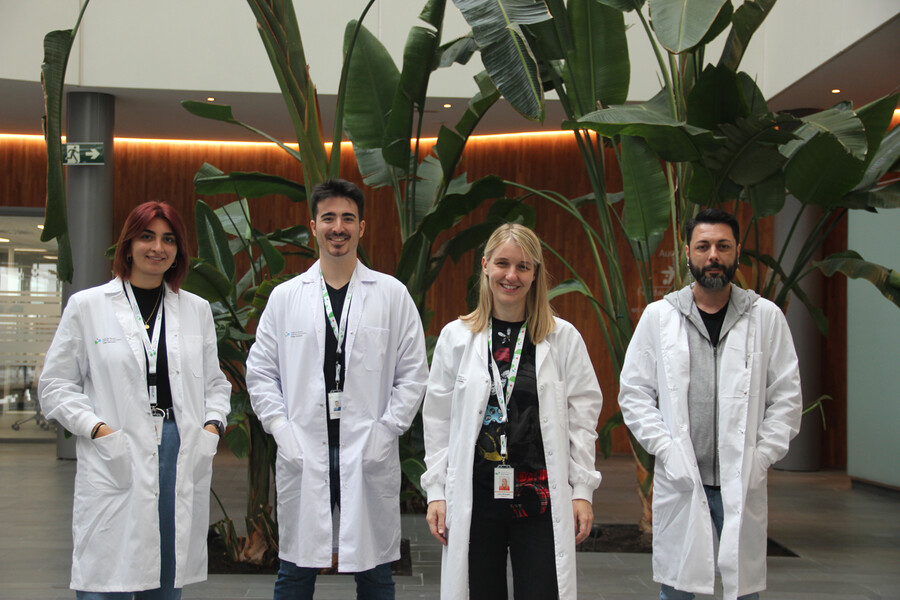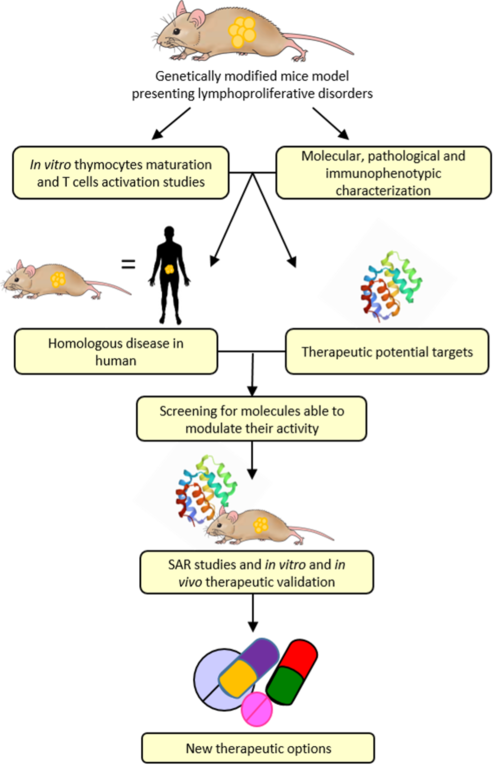
OVERVIEW
Our research is focused on the better understanding of the molecular mechanisms leading to T cell lymphomas appearance. We will develop our research by determining possible defective mechanisms during thymopoiesis and, by developing preclinical mice models for the study of T cell lymphomas, such as angioimmunoblastic T cell lymphoma.
With this knowledge we expect to design and validate new therapeutic treatments more specific and effective than the ones currently available to improve patient’s survival and quality of life.
OUR RESEARCH
T cell lymphomas can be defined as a group of malignancies caused by the uncontrolled proliferation of T cells. They constitute less than 15% of all non-Hodgkin’s lymphomas and within this group frequency can vary enormously.
Despite all being caused by T cell defective cell growth little is known about its specific origin. Besides, they present a wide variety of symptoms and clinical characteristics ranging from highly aggressive (fast-growing) lymphomas to subtypes that can develop for years without endangering the patient's life (indolent); presence of enlarged spleen, liver and/or lymph nodes; eczema and skin rash appearance; age appearance and higher incidence in men than in women. As a result, it is often difficult to establish a correct diagnosis of the disease and even more difficult to design an appropriate therapy for its specific treatment.
In this sense, our line of research aims at improving our understanding of the molecular mechanisms leading to the defective behavior of the T cells originating this type of lymphoma. To develop our objective we will employ immunology, functional genomics, molecular biology, and medicinal chemistry techniques.
Specifically, we will make use of potential and already described genetically modified mice models as pre-clinical models for the study of different subtypes of T cell lymphomas and we will:
- Characterize their phenotype once the disease is developed to find the specific T cell population inducing its appearance.
- Study thymocytes maturation processes and mature T cells response to antigens to try to determine if lymphoma appearance can be already settled during thymopoiesis or once the T cells leave the thymus.
- Compare by genomic techniques like single cell sequencing the characteristics of defective thymocytes and T cells in mice models and try to find similarities in human patient’s samples and databases.
With the information obtained, we aim at finding new therapeutic targets in order to:
- Develop chemical libraries screening assays for drug discovery to modulate the activity of these therapeutic targets
- Perform structure-activity assays and possible administration in form of nanomedicines to optimize their biological activity and cellular uptake in vitro
- Validate their use as new therapeutic strategies alone or in combination with other chemotherapeutics employing mice models of the disease.

OUR GOALS
To make available new therapies to treat angioimmunoblastic T cell lymphoma and reduce mortality in those patients. The most important one would be to improve life expectancy of patient’s suffering from this type of disease. Although, we would like to apply our research to different types of T cell lymphomas, we are initially focused on the study of molecular mechanisms leading to angioimmunoblastic T cell lymphoma. This type of disease has no specific treatment and all the strategies chosen so far have not improved patient’s survival in the last 3 decades. Finding new strategies will for sure improve their chances to recover from this disease and it will significantly improve their quality of life. To unveil the molecular mechanisms leading to T cell lymphoma appearance and to provide new therapeutic targets to design more specific and effective therapeutic treatments to fight these group of hematological diseases.
OUR CHALLENGES
In summary, our line of research will have the final objective to provide more specific and effective therapies to treat T cell lymphoma to find a cure or, if not, to improve the prognosis and quality of life of patients.
- Disease Knowledge deepening
- Drug development
There are some questions we are trying to answer with our research:
1. When does defects in T cells leading to T cell lymphoma appearance start?
2. Which are the specific T cell populations responsible for T cell lymphoma induction?
3. Can we design more specific and effective therapeutic treatments for this type of disease?
Selected Publications
Current Grants
PID2023-149829OB-I00
Ministerio de ciencia, innovación y universidades
T-SWITCH Cambio de linaje en células T e inhibición de la muerte celular en el origen del linfoma angioinmunoblástico de células T
Fundació internacional josep carreras
Defective cell death inducing T cell receptor revision at the root of angioimmunoblastic T cell lymphoma origin and other potancial autoimmune diseases
RYC2019-026522-I
Ministerio de ciencia, innovación y universidades



